A Report on the Management of Quality in Health and Social Care
VerifiedAdded on 2022/12/28
|12
|2823
|31
Report
AI Summary
This report delves into the critical aspects of quality management within the health and social care sector. It begins by defining quality and its importance, then explores the role of quality assurance. The report critically analyzes quality models such as Six Sigma and Total Quality Management, evaluating their application in ensuring treatment quality. It examines the Care Quality Commission (CQC) and its role in maintaining standards, as well as the significance of benchmarks in the healthcare sector. The report further evaluates methods for gathering feedback to improve quality, identifies key stakeholders in quality delivery, and assesses strategies for enhancing service user safety. It highlights the importance of technological advancements and continuous improvement in achieving patient satisfaction and efficient healthcare processes.
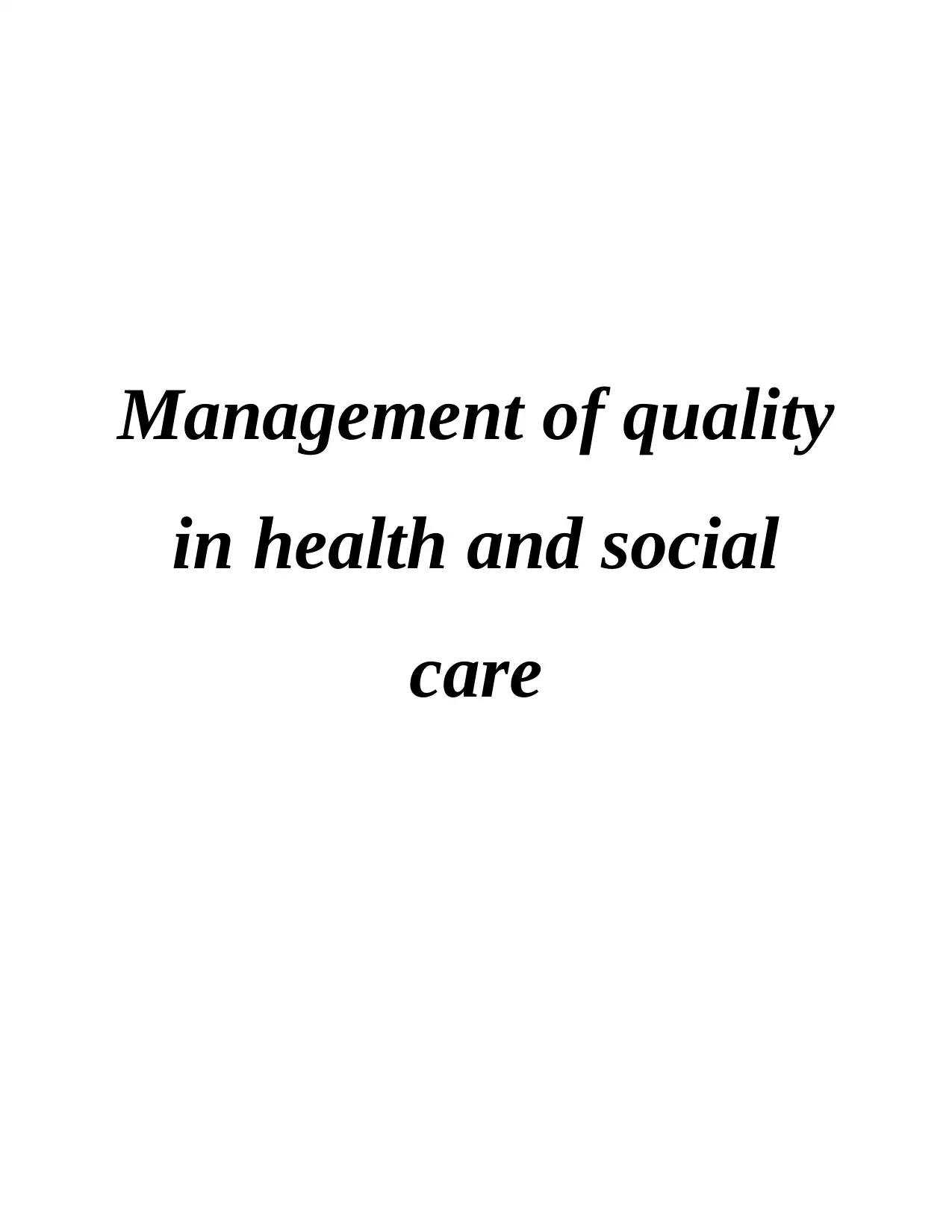
Management of quality
in health and social
care
in health and social
care
Paraphrase This Document
Need a fresh take? Get an instant paraphrase of this document with our AI Paraphraser
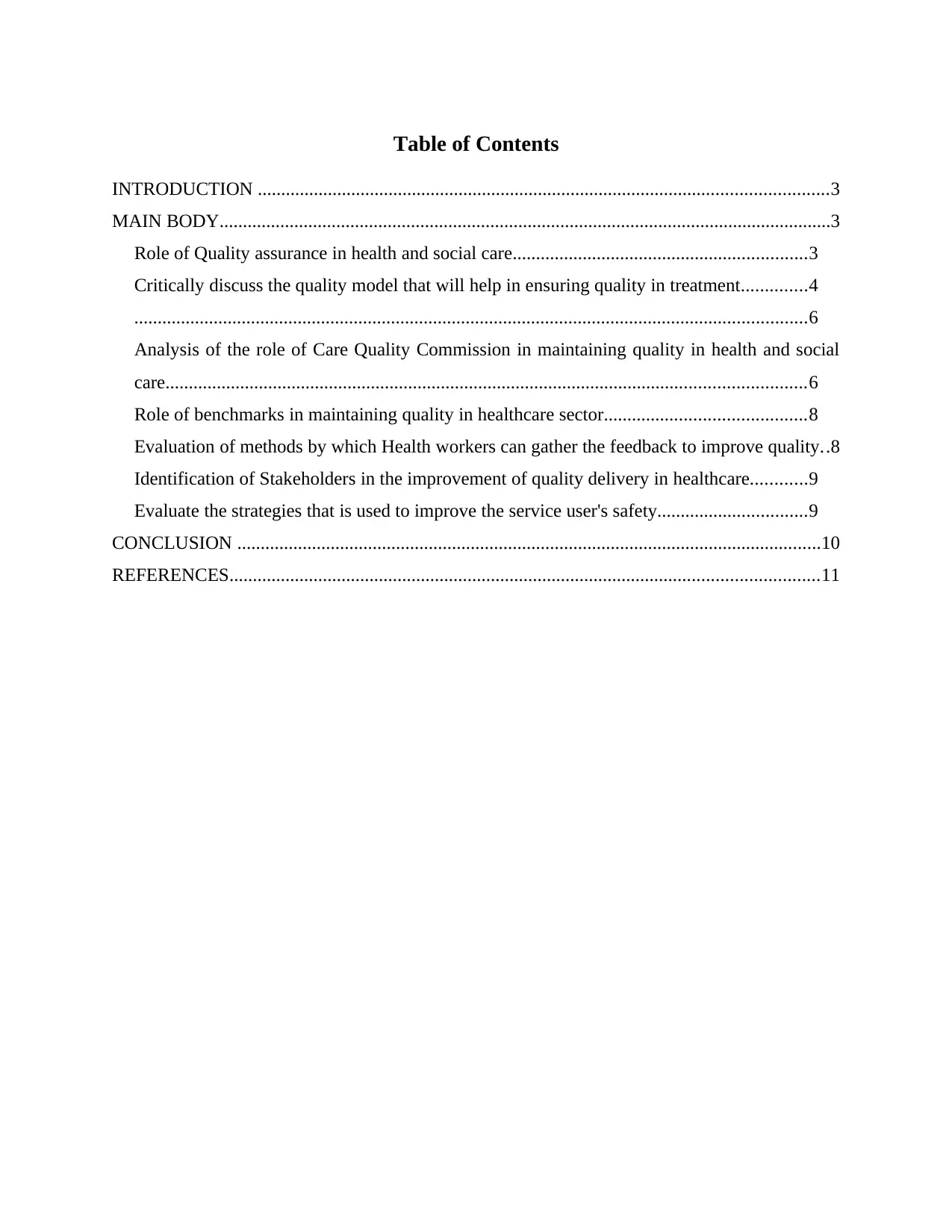
Table of Contents
INTRODUCTION ..........................................................................................................................3
MAIN BODY...................................................................................................................................3
Role of Quality assurance in health and social care...............................................................3
Critically discuss the quality model that will help in ensuring quality in treatment..............4
................................................................................................................................................6
Analysis of the role of Care Quality Commission in maintaining quality in health and social
care.........................................................................................................................................6
Role of benchmarks in maintaining quality in healthcare sector...........................................8
Evaluation of methods by which Health workers can gather the feedback to improve quality..8
Identification of Stakeholders in the improvement of quality delivery in healthcare............9
Evaluate the strategies that is used to improve the service user's safety................................9
CONCLUSION .............................................................................................................................10
REFERENCES..............................................................................................................................11
INTRODUCTION ..........................................................................................................................3
MAIN BODY...................................................................................................................................3
Role of Quality assurance in health and social care...............................................................3
Critically discuss the quality model that will help in ensuring quality in treatment..............4
................................................................................................................................................6
Analysis of the role of Care Quality Commission in maintaining quality in health and social
care.........................................................................................................................................6
Role of benchmarks in maintaining quality in healthcare sector...........................................8
Evaluation of methods by which Health workers can gather the feedback to improve quality..8
Identification of Stakeholders in the improvement of quality delivery in healthcare............9
Evaluate the strategies that is used to improve the service user's safety................................9
CONCLUSION .............................................................................................................................10
REFERENCES..............................................................................................................................11
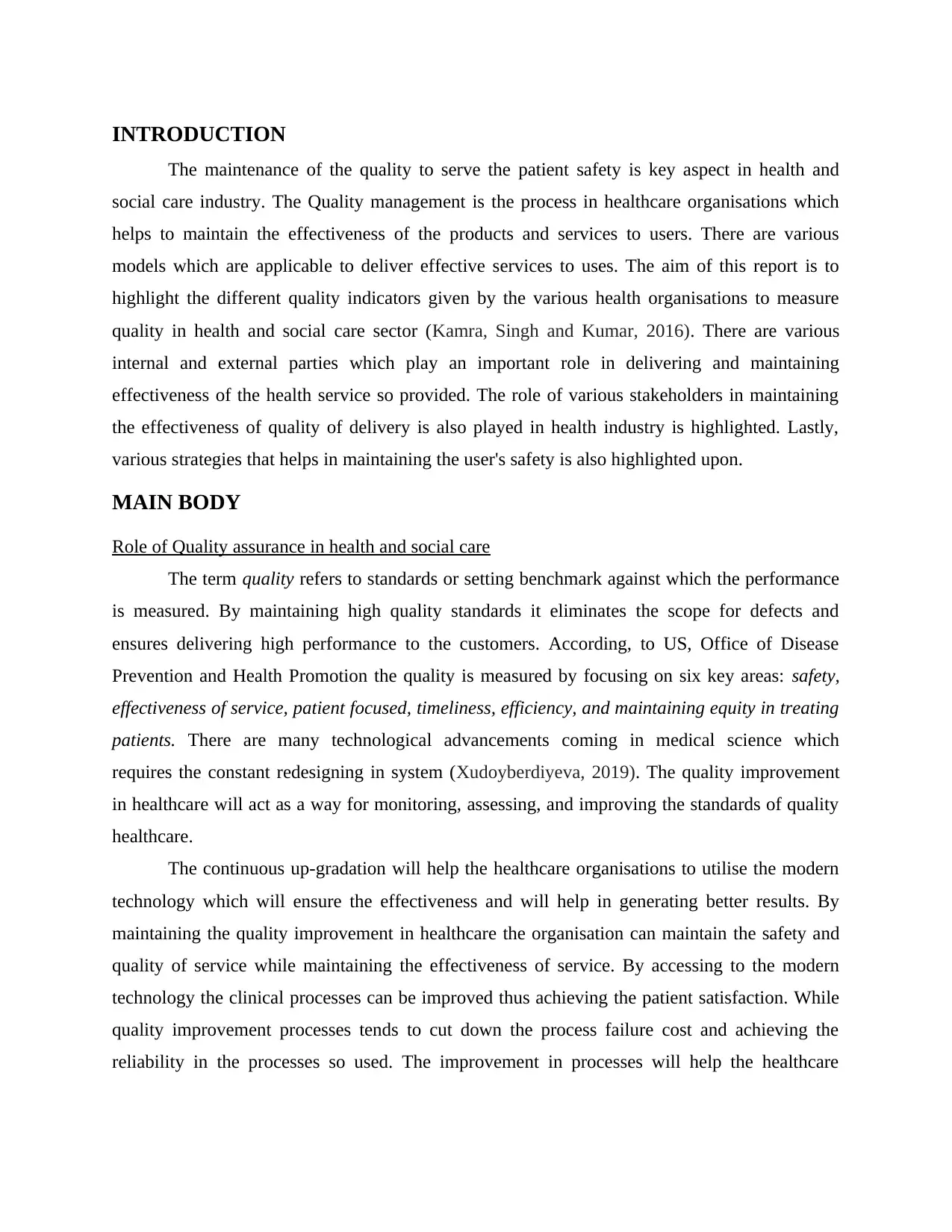
INTRODUCTION
The maintenance of the quality to serve the patient safety is key aspect in health and
social care industry. The Quality management is the process in healthcare organisations which
helps to maintain the effectiveness of the products and services to users. There are various
models which are applicable to deliver effective services to uses. The aim of this report is to
highlight the different quality indicators given by the various health organisations to measure
quality in health and social care sector (Kamra, Singh and Kumar, 2016). There are various
internal and external parties which play an important role in delivering and maintaining
effectiveness of the health service so provided. The role of various stakeholders in maintaining
the effectiveness of quality of delivery is also played in health industry is highlighted. Lastly,
various strategies that helps in maintaining the user's safety is also highlighted upon.
MAIN BODY
Role of Quality assurance in health and social care
The term quality refers to standards or setting benchmark against which the performance
is measured. By maintaining high quality standards it eliminates the scope for defects and
ensures delivering high performance to the customers. According, to US, Office of Disease
Prevention and Health Promotion the quality is measured by focusing on six key areas: safety,
effectiveness of service, patient focused, timeliness, efficiency, and maintaining equity in treating
patients. There are many technological advancements coming in medical science which
requires the constant redesigning in system (Xudoyberdiyeva, 2019). The quality improvement
in healthcare will act as a way for monitoring, assessing, and improving the standards of quality
healthcare.
The continuous up-gradation will help the healthcare organisations to utilise the modern
technology which will ensure the effectiveness and will help in generating better results. By
maintaining the quality improvement in healthcare the organisation can maintain the safety and
quality of service while maintaining the effectiveness of service. By accessing to the modern
technology the clinical processes can be improved thus achieving the patient satisfaction. While
quality improvement processes tends to cut down the process failure cost and achieving the
reliability in the processes so used. The improvement in processes will help the healthcare
The maintenance of the quality to serve the patient safety is key aspect in health and
social care industry. The Quality management is the process in healthcare organisations which
helps to maintain the effectiveness of the products and services to users. There are various
models which are applicable to deliver effective services to uses. The aim of this report is to
highlight the different quality indicators given by the various health organisations to measure
quality in health and social care sector (Kamra, Singh and Kumar, 2016). There are various
internal and external parties which play an important role in delivering and maintaining
effectiveness of the health service so provided. The role of various stakeholders in maintaining
the effectiveness of quality of delivery is also played in health industry is highlighted. Lastly,
various strategies that helps in maintaining the user's safety is also highlighted upon.
MAIN BODY
Role of Quality assurance in health and social care
The term quality refers to standards or setting benchmark against which the performance
is measured. By maintaining high quality standards it eliminates the scope for defects and
ensures delivering high performance to the customers. According, to US, Office of Disease
Prevention and Health Promotion the quality is measured by focusing on six key areas: safety,
effectiveness of service, patient focused, timeliness, efficiency, and maintaining equity in treating
patients. There are many technological advancements coming in medical science which
requires the constant redesigning in system (Xudoyberdiyeva, 2019). The quality improvement
in healthcare will act as a way for monitoring, assessing, and improving the standards of quality
healthcare.
The continuous up-gradation will help the healthcare organisations to utilise the modern
technology which will ensure the effectiveness and will help in generating better results. By
maintaining the quality improvement in healthcare the organisation can maintain the safety and
quality of service while maintaining the effectiveness of service. By accessing to the modern
technology the clinical processes can be improved thus achieving the patient satisfaction. While
quality improvement processes tends to cut down the process failure cost and achieving the
reliability in the processes so used. The improvement in processes will help the healthcare
⊘ This is a preview!⊘
Do you want full access?
Subscribe today to unlock all pages.

Trusted by 1+ million students worldwide
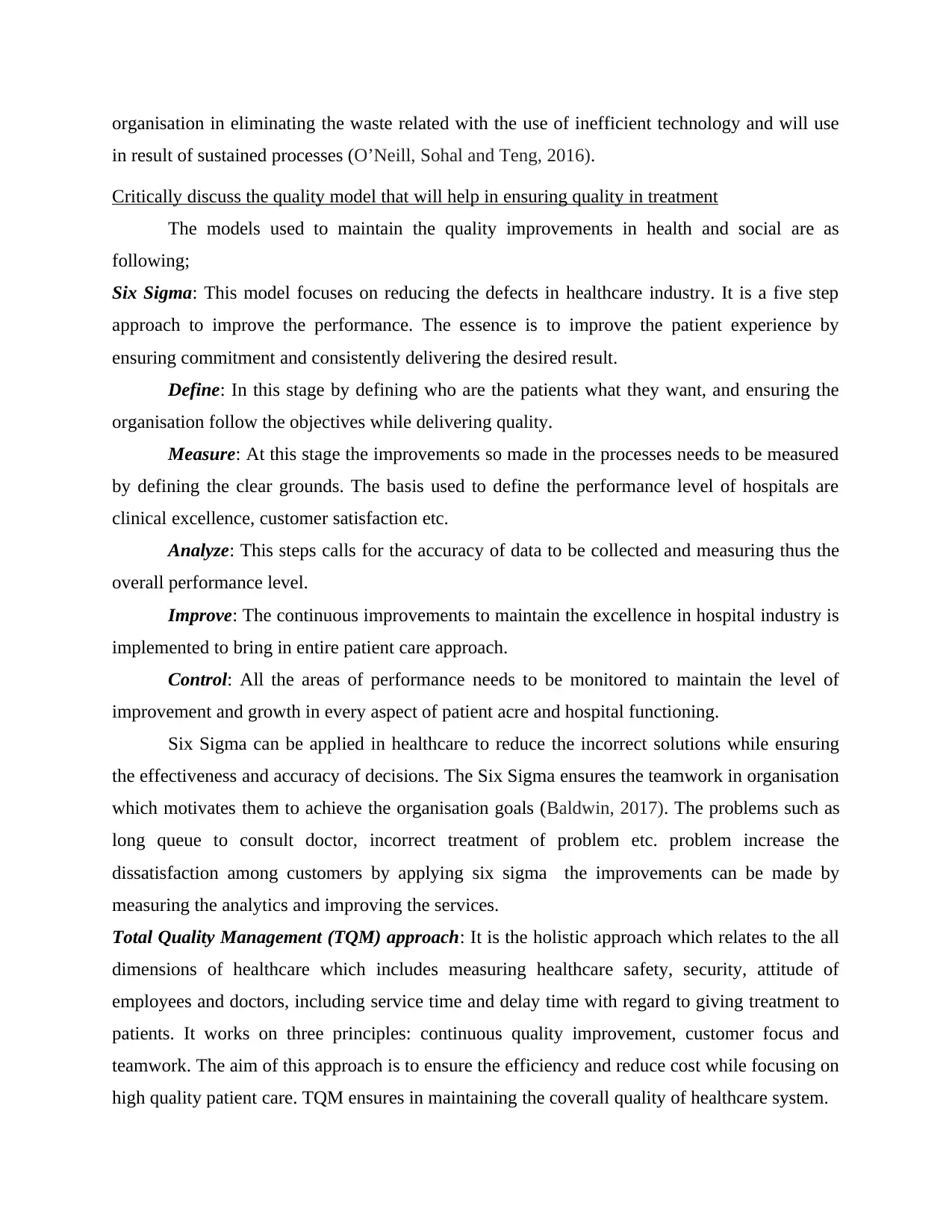
organisation in eliminating the waste related with the use of inefficient technology and will use
in result of sustained processes (O’Neill, Sohal and Teng, 2016).
Critically discuss the quality model that will help in ensuring quality in treatment
The models used to maintain the quality improvements in health and social are as
following;
Six Sigma: This model focuses on reducing the defects in healthcare industry. It is a five step
approach to improve the performance. The essence is to improve the patient experience by
ensuring commitment and consistently delivering the desired result.
Define: In this stage by defining who are the patients what they want, and ensuring the
organisation follow the objectives while delivering quality.
Measure: At this stage the improvements so made in the processes needs to be measured
by defining the clear grounds. The basis used to define the performance level of hospitals are
clinical excellence, customer satisfaction etc.
Analyze: This steps calls for the accuracy of data to be collected and measuring thus the
overall performance level.
Improve: The continuous improvements to maintain the excellence in hospital industry is
implemented to bring in entire patient care approach.
Control: All the areas of performance needs to be monitored to maintain the level of
improvement and growth in every aspect of patient acre and hospital functioning.
Six Sigma can be applied in healthcare to reduce the incorrect solutions while ensuring
the effectiveness and accuracy of decisions. The Six Sigma ensures the teamwork in organisation
which motivates them to achieve the organisation goals (Baldwin, 2017). The problems such as
long queue to consult doctor, incorrect treatment of problem etc. problem increase the
dissatisfaction among customers by applying six sigma the improvements can be made by
measuring the analytics and improving the services.
Total Quality Management (TQM) approach: It is the holistic approach which relates to the all
dimensions of healthcare which includes measuring healthcare safety, security, attitude of
employees and doctors, including service time and delay time with regard to giving treatment to
patients. It works on three principles: continuous quality improvement, customer focus and
teamwork. The aim of this approach is to ensure the efficiency and reduce cost while focusing on
high quality patient care. TQM ensures in maintaining the coverall quality of healthcare system.
in result of sustained processes (O’Neill, Sohal and Teng, 2016).
Critically discuss the quality model that will help in ensuring quality in treatment
The models used to maintain the quality improvements in health and social are as
following;
Six Sigma: This model focuses on reducing the defects in healthcare industry. It is a five step
approach to improve the performance. The essence is to improve the patient experience by
ensuring commitment and consistently delivering the desired result.
Define: In this stage by defining who are the patients what they want, and ensuring the
organisation follow the objectives while delivering quality.
Measure: At this stage the improvements so made in the processes needs to be measured
by defining the clear grounds. The basis used to define the performance level of hospitals are
clinical excellence, customer satisfaction etc.
Analyze: This steps calls for the accuracy of data to be collected and measuring thus the
overall performance level.
Improve: The continuous improvements to maintain the excellence in hospital industry is
implemented to bring in entire patient care approach.
Control: All the areas of performance needs to be monitored to maintain the level of
improvement and growth in every aspect of patient acre and hospital functioning.
Six Sigma can be applied in healthcare to reduce the incorrect solutions while ensuring
the effectiveness and accuracy of decisions. The Six Sigma ensures the teamwork in organisation
which motivates them to achieve the organisation goals (Baldwin, 2017). The problems such as
long queue to consult doctor, incorrect treatment of problem etc. problem increase the
dissatisfaction among customers by applying six sigma the improvements can be made by
measuring the analytics and improving the services.
Total Quality Management (TQM) approach: It is the holistic approach which relates to the all
dimensions of healthcare which includes measuring healthcare safety, security, attitude of
employees and doctors, including service time and delay time with regard to giving treatment to
patients. It works on three principles: continuous quality improvement, customer focus and
teamwork. The aim of this approach is to ensure the efficiency and reduce cost while focusing on
high quality patient care. TQM ensures in maintaining the coverall quality of healthcare system.
Paraphrase This Document
Need a fresh take? Get an instant paraphrase of this document with our AI Paraphraser
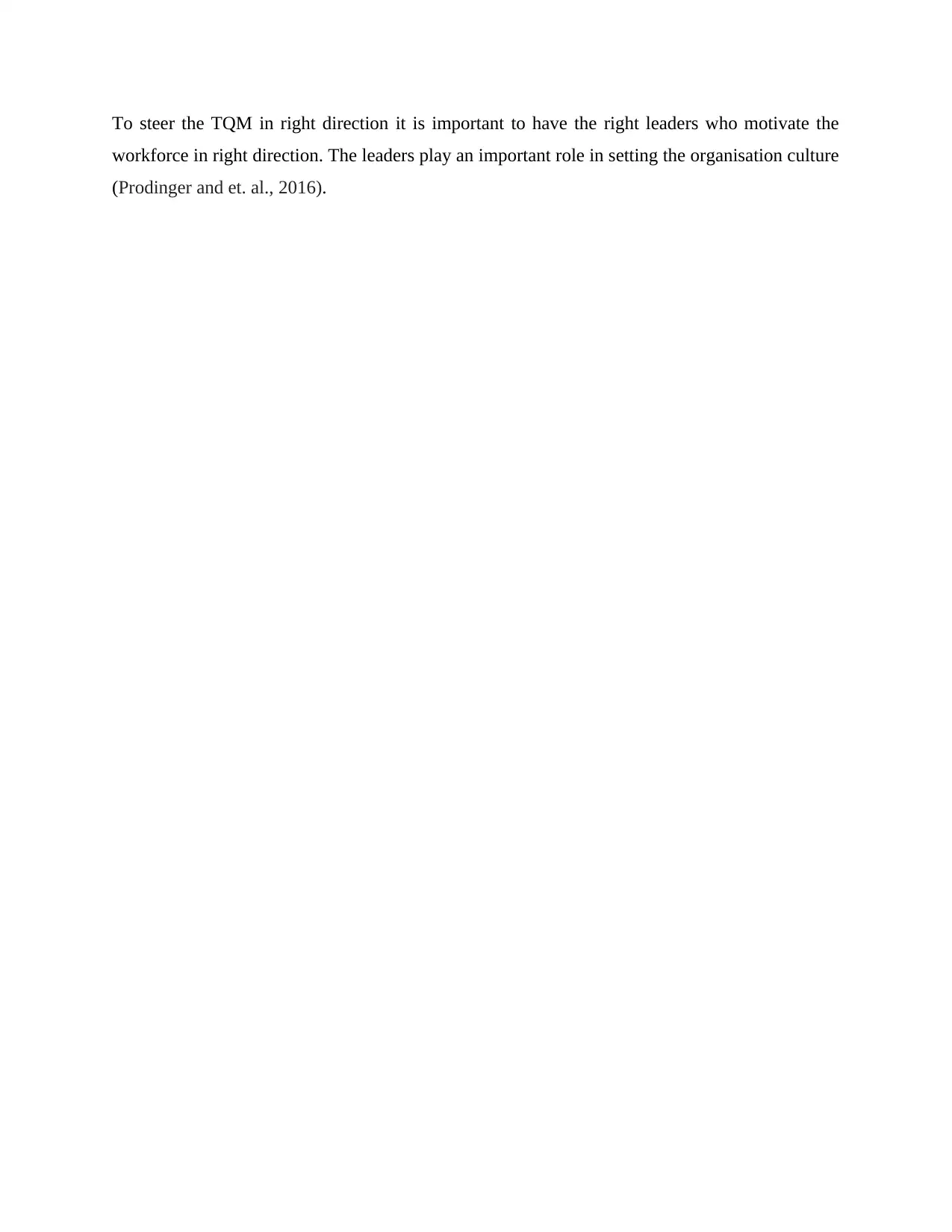
To steer the TQM in right direction it is important to have the right leaders who motivate the
workforce in right direction. The leaders play an important role in setting the organisation culture
(Prodinger and et. al., 2016).
workforce in right direction. The leaders play an important role in setting the organisation culture
(Prodinger and et. al., 2016).
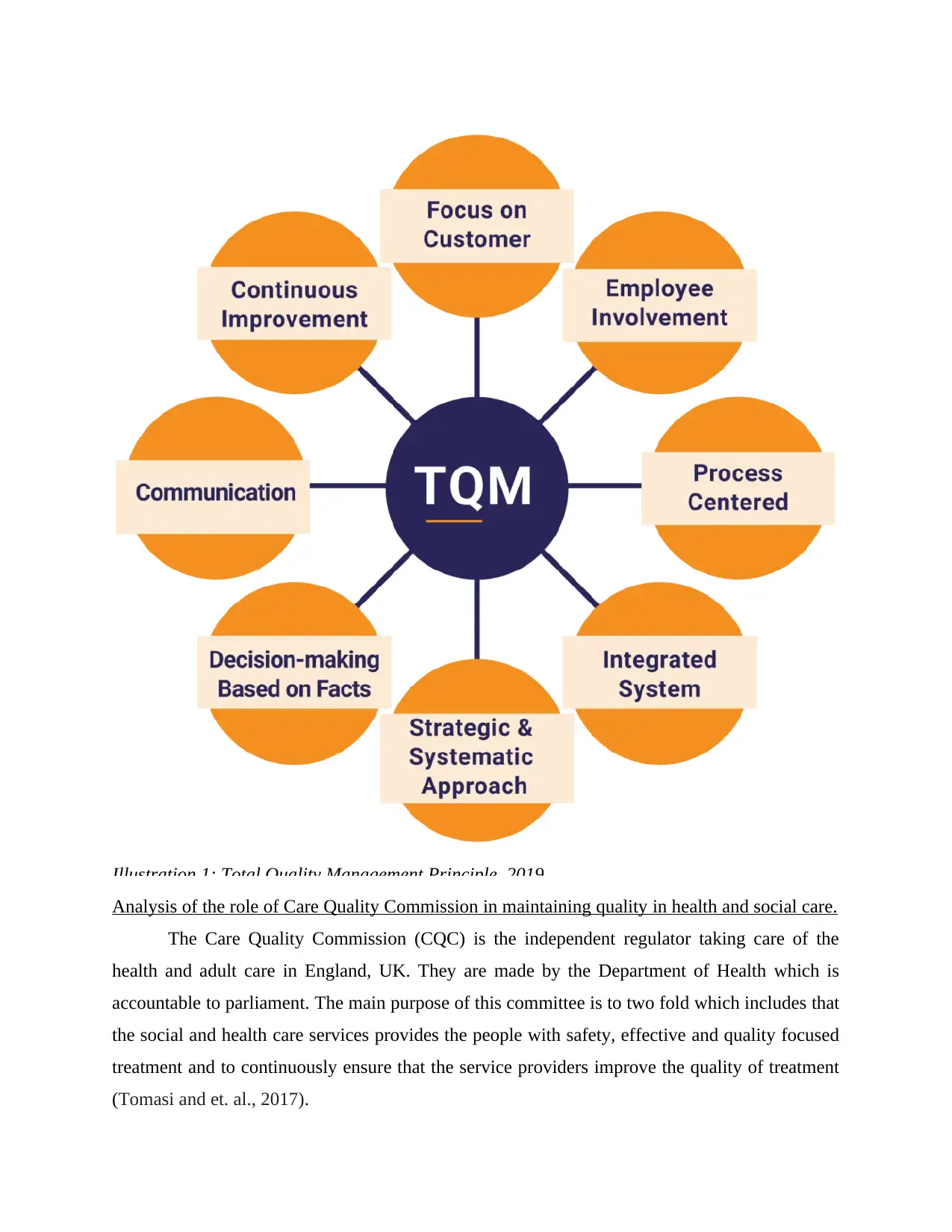
Illustration 1: Total Quality Management Principle, 2019
Analysis of the role of Care Quality Commission in maintaining quality in health and social care.
The Care Quality Commission (CQC) is the independent regulator taking care of the
health and adult care in England, UK. They are made by the Department of Health which is
accountable to parliament. The main purpose of this committee is to two fold which includes that
the social and health care services provides the people with safety, effective and quality focused
treatment and to continuously ensure that the service providers improve the quality of treatment
(Tomasi and et. al., 2017).
Analysis of the role of Care Quality Commission in maintaining quality in health and social care.
The Care Quality Commission (CQC) is the independent regulator taking care of the
health and adult care in England, UK. They are made by the Department of Health which is
accountable to parliament. The main purpose of this committee is to two fold which includes that
the social and health care services provides the people with safety, effective and quality focused
treatment and to continuously ensure that the service providers improve the quality of treatment
(Tomasi and et. al., 2017).
⊘ This is a preview!⊘
Do you want full access?
Subscribe today to unlock all pages.

Trusted by 1+ million students worldwide
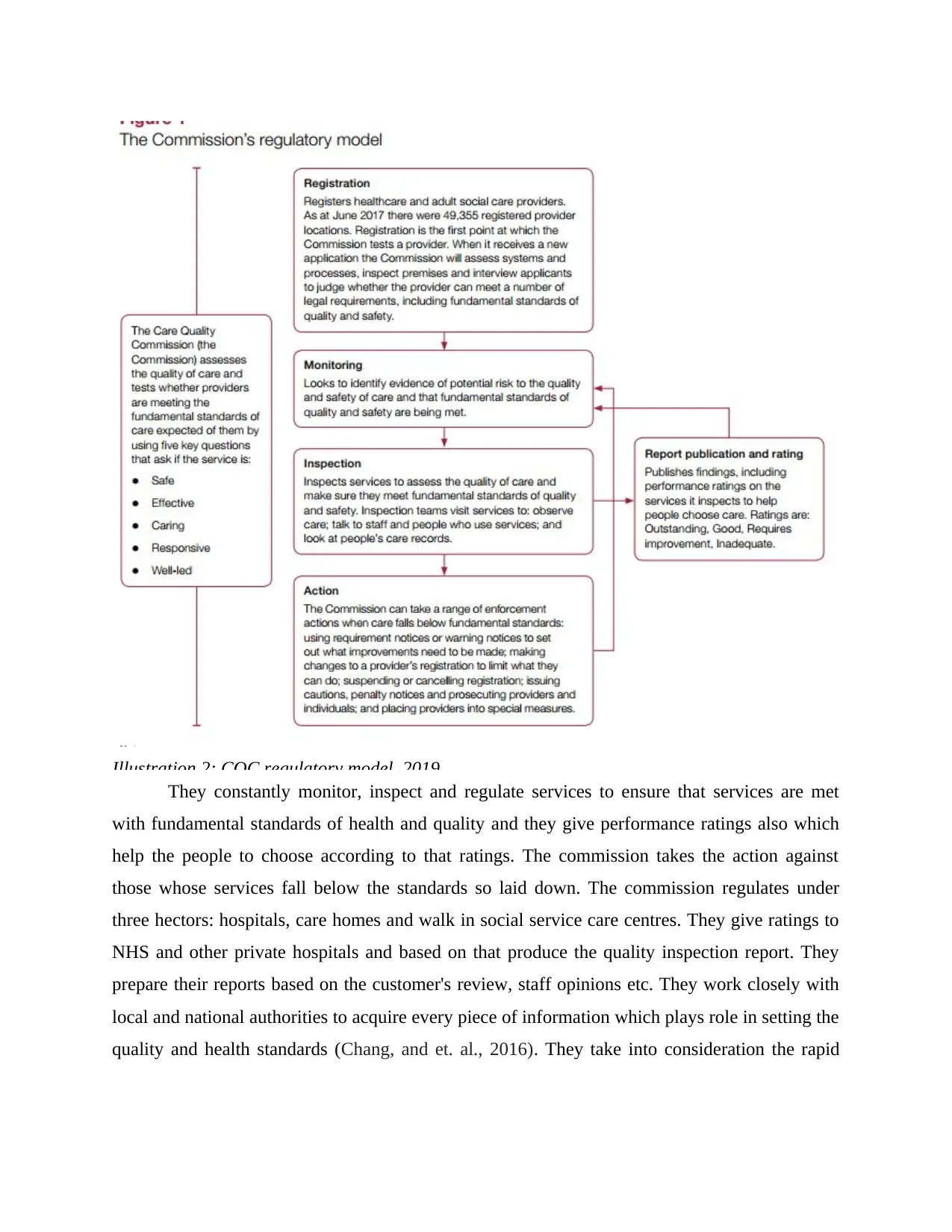
Illustration 2: CQC regulatory model, 2019
They constantly monitor, inspect and regulate services to ensure that services are met
with fundamental standards of health and quality and they give performance ratings also which
help the people to choose according to that ratings. The commission takes the action against
those whose services fall below the standards so laid down. The commission regulates under
three hectors: hospitals, care homes and walk in social service care centres. They give ratings to
NHS and other private hospitals and based on that produce the quality inspection report. They
prepare their reports based on the customer's review, staff opinions etc. They work closely with
local and national authorities to acquire every piece of information which plays role in setting the
quality and health standards (Chang, and et. al., 2016). They take into consideration the rapid
They constantly monitor, inspect and regulate services to ensure that services are met
with fundamental standards of health and quality and they give performance ratings also which
help the people to choose according to that ratings. The commission takes the action against
those whose services fall below the standards so laid down. The commission regulates under
three hectors: hospitals, care homes and walk in social service care centres. They give ratings to
NHS and other private hospitals and based on that produce the quality inspection report. They
prepare their reports based on the customer's review, staff opinions etc. They work closely with
local and national authorities to acquire every piece of information which plays role in setting the
quality and health standards (Chang, and et. al., 2016). They take into consideration the rapid
Paraphrase This Document
Need a fresh take? Get an instant paraphrase of this document with our AI Paraphraser
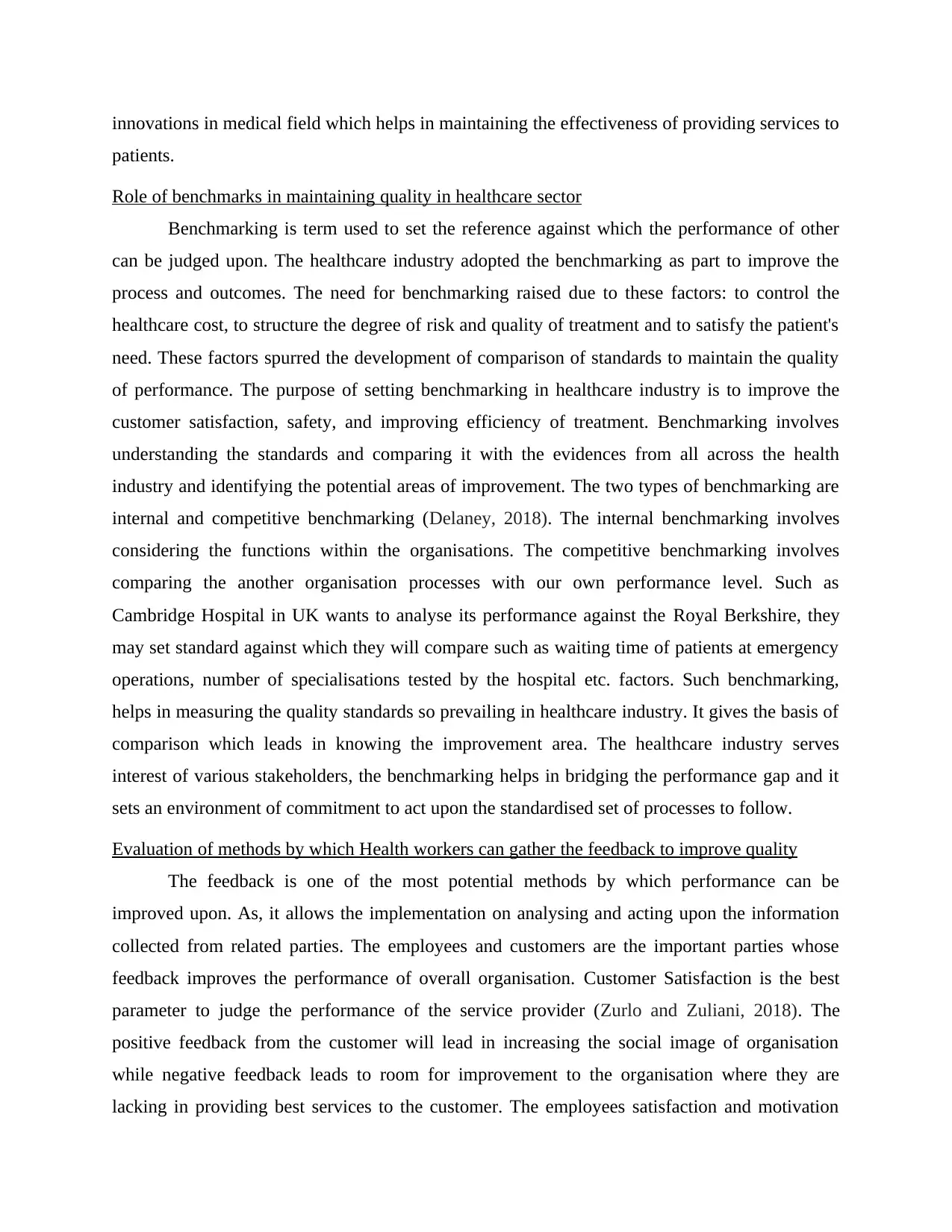
innovations in medical field which helps in maintaining the effectiveness of providing services to
patients.
Role of benchmarks in maintaining quality in healthcare sector
Benchmarking is term used to set the reference against which the performance of other
can be judged upon. The healthcare industry adopted the benchmarking as part to improve the
process and outcomes. The need for benchmarking raised due to these factors: to control the
healthcare cost, to structure the degree of risk and quality of treatment and to satisfy the patient's
need. These factors spurred the development of comparison of standards to maintain the quality
of performance. The purpose of setting benchmarking in healthcare industry is to improve the
customer satisfaction, safety, and improving efficiency of treatment. Benchmarking involves
understanding the standards and comparing it with the evidences from all across the health
industry and identifying the potential areas of improvement. The two types of benchmarking are
internal and competitive benchmarking (Delaney, 2018). The internal benchmarking involves
considering the functions within the organisations. The competitive benchmarking involves
comparing the another organisation processes with our own performance level. Such as
Cambridge Hospital in UK wants to analyse its performance against the Royal Berkshire, they
may set standard against which they will compare such as waiting time of patients at emergency
operations, number of specialisations tested by the hospital etc. factors. Such benchmarking,
helps in measuring the quality standards so prevailing in healthcare industry. It gives the basis of
comparison which leads in knowing the improvement area. The healthcare industry serves
interest of various stakeholders, the benchmarking helps in bridging the performance gap and it
sets an environment of commitment to act upon the standardised set of processes to follow.
Evaluation of methods by which Health workers can gather the feedback to improve quality
The feedback is one of the most potential methods by which performance can be
improved upon. As, it allows the implementation on analysing and acting upon the information
collected from related parties. The employees and customers are the important parties whose
feedback improves the performance of overall organisation. Customer Satisfaction is the best
parameter to judge the performance of the service provider (Zurlo and Zuliani, 2018). The
positive feedback from the customer will lead in increasing the social image of organisation
while negative feedback leads to room for improvement to the organisation where they are
lacking in providing best services to the customer. The employees satisfaction and motivation
patients.
Role of benchmarks in maintaining quality in healthcare sector
Benchmarking is term used to set the reference against which the performance of other
can be judged upon. The healthcare industry adopted the benchmarking as part to improve the
process and outcomes. The need for benchmarking raised due to these factors: to control the
healthcare cost, to structure the degree of risk and quality of treatment and to satisfy the patient's
need. These factors spurred the development of comparison of standards to maintain the quality
of performance. The purpose of setting benchmarking in healthcare industry is to improve the
customer satisfaction, safety, and improving efficiency of treatment. Benchmarking involves
understanding the standards and comparing it with the evidences from all across the health
industry and identifying the potential areas of improvement. The two types of benchmarking are
internal and competitive benchmarking (Delaney, 2018). The internal benchmarking involves
considering the functions within the organisations. The competitive benchmarking involves
comparing the another organisation processes with our own performance level. Such as
Cambridge Hospital in UK wants to analyse its performance against the Royal Berkshire, they
may set standard against which they will compare such as waiting time of patients at emergency
operations, number of specialisations tested by the hospital etc. factors. Such benchmarking,
helps in measuring the quality standards so prevailing in healthcare industry. It gives the basis of
comparison which leads in knowing the improvement area. The healthcare industry serves
interest of various stakeholders, the benchmarking helps in bridging the performance gap and it
sets an environment of commitment to act upon the standardised set of processes to follow.
Evaluation of methods by which Health workers can gather the feedback to improve quality
The feedback is one of the most potential methods by which performance can be
improved upon. As, it allows the implementation on analysing and acting upon the information
collected from related parties. The employees and customers are the important parties whose
feedback improves the performance of overall organisation. Customer Satisfaction is the best
parameter to judge the performance of the service provider (Zurlo and Zuliani, 2018). The
positive feedback from the customer will lead in increasing the social image of organisation
while negative feedback leads to room for improvement to the organisation where they are
lacking in providing best services to the customer. The employees satisfaction and motivation
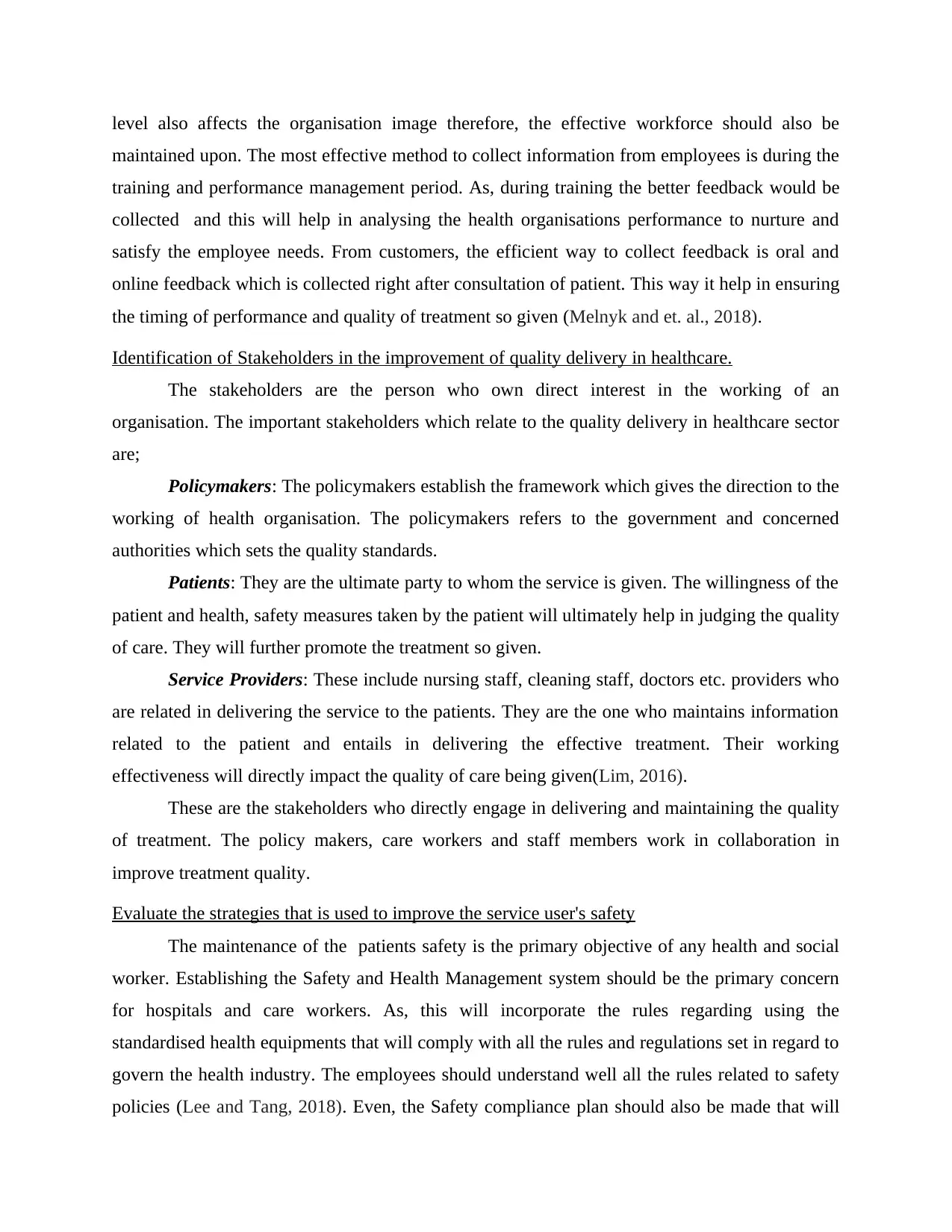
level also affects the organisation image therefore, the effective workforce should also be
maintained upon. The most effective method to collect information from employees is during the
training and performance management period. As, during training the better feedback would be
collected and this will help in analysing the health organisations performance to nurture and
satisfy the employee needs. From customers, the efficient way to collect feedback is oral and
online feedback which is collected right after consultation of patient. This way it help in ensuring
the timing of performance and quality of treatment so given (Melnyk and et. al., 2018).
Identification of Stakeholders in the improvement of quality delivery in healthcare.
The stakeholders are the person who own direct interest in the working of an
organisation. The important stakeholders which relate to the quality delivery in healthcare sector
are;
Policymakers: The policymakers establish the framework which gives the direction to the
working of health organisation. The policymakers refers to the government and concerned
authorities which sets the quality standards.
Patients: They are the ultimate party to whom the service is given. The willingness of the
patient and health, safety measures taken by the patient will ultimately help in judging the quality
of care. They will further promote the treatment so given.
Service Providers: These include nursing staff, cleaning staff, doctors etc. providers who
are related in delivering the service to the patients. They are the one who maintains information
related to the patient and entails in delivering the effective treatment. Their working
effectiveness will directly impact the quality of care being given(Lim, 2016).
These are the stakeholders who directly engage in delivering and maintaining the quality
of treatment. The policy makers, care workers and staff members work in collaboration in
improve treatment quality.
Evaluate the strategies that is used to improve the service user's safety
The maintenance of the patients safety is the primary objective of any health and social
worker. Establishing the Safety and Health Management system should be the primary concern
for hospitals and care workers. As, this will incorporate the rules regarding using the
standardised health equipments that will comply with all the rules and regulations set in regard to
govern the health industry. The employees should understand well all the rules related to safety
policies (Lee and Tang, 2018). Even, the Safety compliance plan should also be made that will
maintained upon. The most effective method to collect information from employees is during the
training and performance management period. As, during training the better feedback would be
collected and this will help in analysing the health organisations performance to nurture and
satisfy the employee needs. From customers, the efficient way to collect feedback is oral and
online feedback which is collected right after consultation of patient. This way it help in ensuring
the timing of performance and quality of treatment so given (Melnyk and et. al., 2018).
Identification of Stakeholders in the improvement of quality delivery in healthcare.
The stakeholders are the person who own direct interest in the working of an
organisation. The important stakeholders which relate to the quality delivery in healthcare sector
are;
Policymakers: The policymakers establish the framework which gives the direction to the
working of health organisation. The policymakers refers to the government and concerned
authorities which sets the quality standards.
Patients: They are the ultimate party to whom the service is given. The willingness of the
patient and health, safety measures taken by the patient will ultimately help in judging the quality
of care. They will further promote the treatment so given.
Service Providers: These include nursing staff, cleaning staff, doctors etc. providers who
are related in delivering the service to the patients. They are the one who maintains information
related to the patient and entails in delivering the effective treatment. Their working
effectiveness will directly impact the quality of care being given(Lim, 2016).
These are the stakeholders who directly engage in delivering and maintaining the quality
of treatment. The policy makers, care workers and staff members work in collaboration in
improve treatment quality.
Evaluate the strategies that is used to improve the service user's safety
The maintenance of the patients safety is the primary objective of any health and social
worker. Establishing the Safety and Health Management system should be the primary concern
for hospitals and care workers. As, this will incorporate the rules regarding using the
standardised health equipments that will comply with all the rules and regulations set in regard to
govern the health industry. The employees should understand well all the rules related to safety
policies (Lee and Tang, 2018). Even, the Safety compliance plan should also be made that will
⊘ This is a preview!⊘
Do you want full access?
Subscribe today to unlock all pages.

Trusted by 1+ million students worldwide
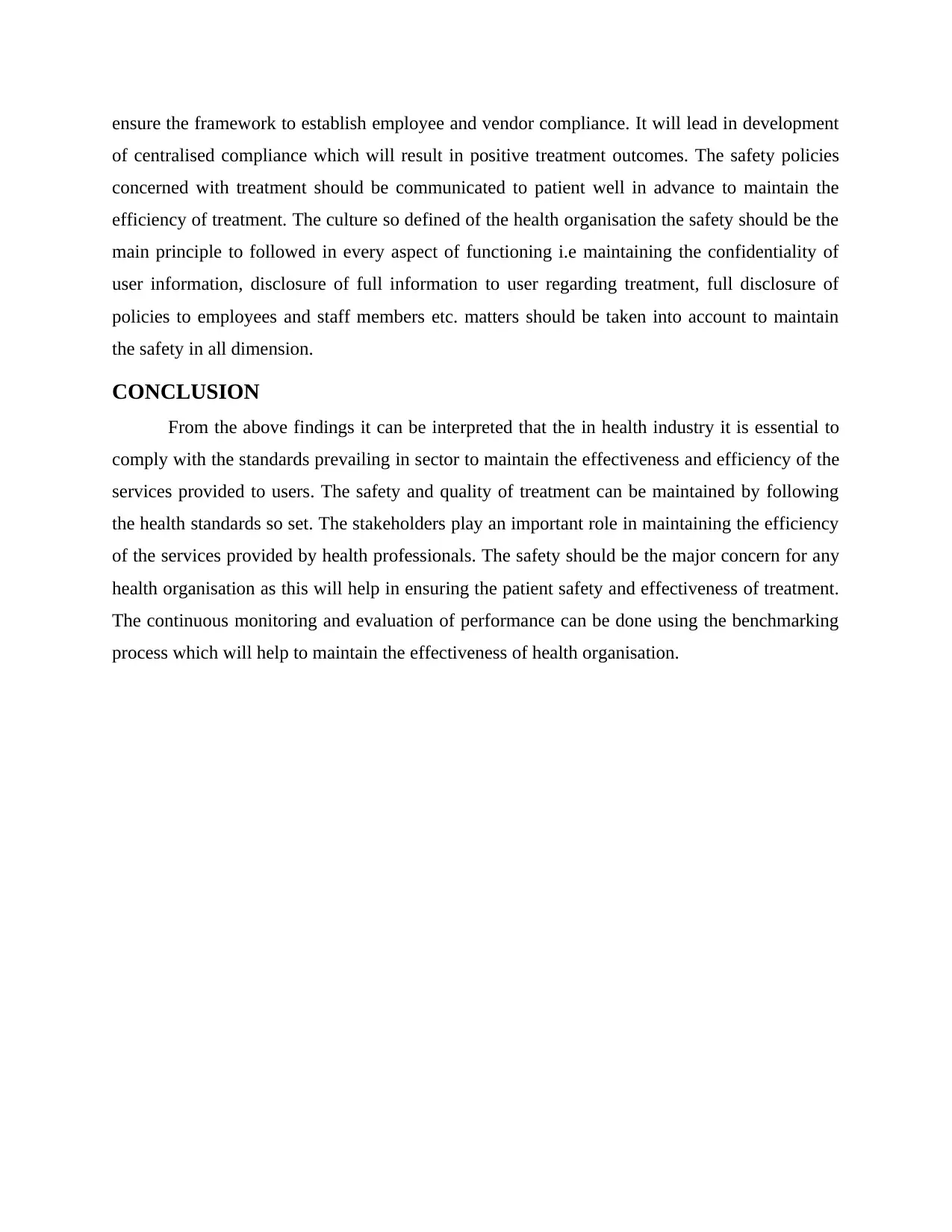
ensure the framework to establish employee and vendor compliance. It will lead in development
of centralised compliance which will result in positive treatment outcomes. The safety policies
concerned with treatment should be communicated to patient well in advance to maintain the
efficiency of treatment. The culture so defined of the health organisation the safety should be the
main principle to followed in every aspect of functioning i.e maintaining the confidentiality of
user information, disclosure of full information to user regarding treatment, full disclosure of
policies to employees and staff members etc. matters should be taken into account to maintain
the safety in all dimension.
CONCLUSION
From the above findings it can be interpreted that the in health industry it is essential to
comply with the standards prevailing in sector to maintain the effectiveness and efficiency of the
services provided to users. The safety and quality of treatment can be maintained by following
the health standards so set. The stakeholders play an important role in maintaining the efficiency
of the services provided by health professionals. The safety should be the major concern for any
health organisation as this will help in ensuring the patient safety and effectiveness of treatment.
The continuous monitoring and evaluation of performance can be done using the benchmarking
process which will help to maintain the effectiveness of health organisation.
of centralised compliance which will result in positive treatment outcomes. The safety policies
concerned with treatment should be communicated to patient well in advance to maintain the
efficiency of treatment. The culture so defined of the health organisation the safety should be the
main principle to followed in every aspect of functioning i.e maintaining the confidentiality of
user information, disclosure of full information to user regarding treatment, full disclosure of
policies to employees and staff members etc. matters should be taken into account to maintain
the safety in all dimension.
CONCLUSION
From the above findings it can be interpreted that the in health industry it is essential to
comply with the standards prevailing in sector to maintain the effectiveness and efficiency of the
services provided to users. The safety and quality of treatment can be maintained by following
the health standards so set. The stakeholders play an important role in maintaining the efficiency
of the services provided by health professionals. The safety should be the major concern for any
health organisation as this will help in ensuring the patient safety and effectiveness of treatment.
The continuous monitoring and evaluation of performance can be done using the benchmarking
process which will help to maintain the effectiveness of health organisation.
Paraphrase This Document
Need a fresh take? Get an instant paraphrase of this document with our AI Paraphraser
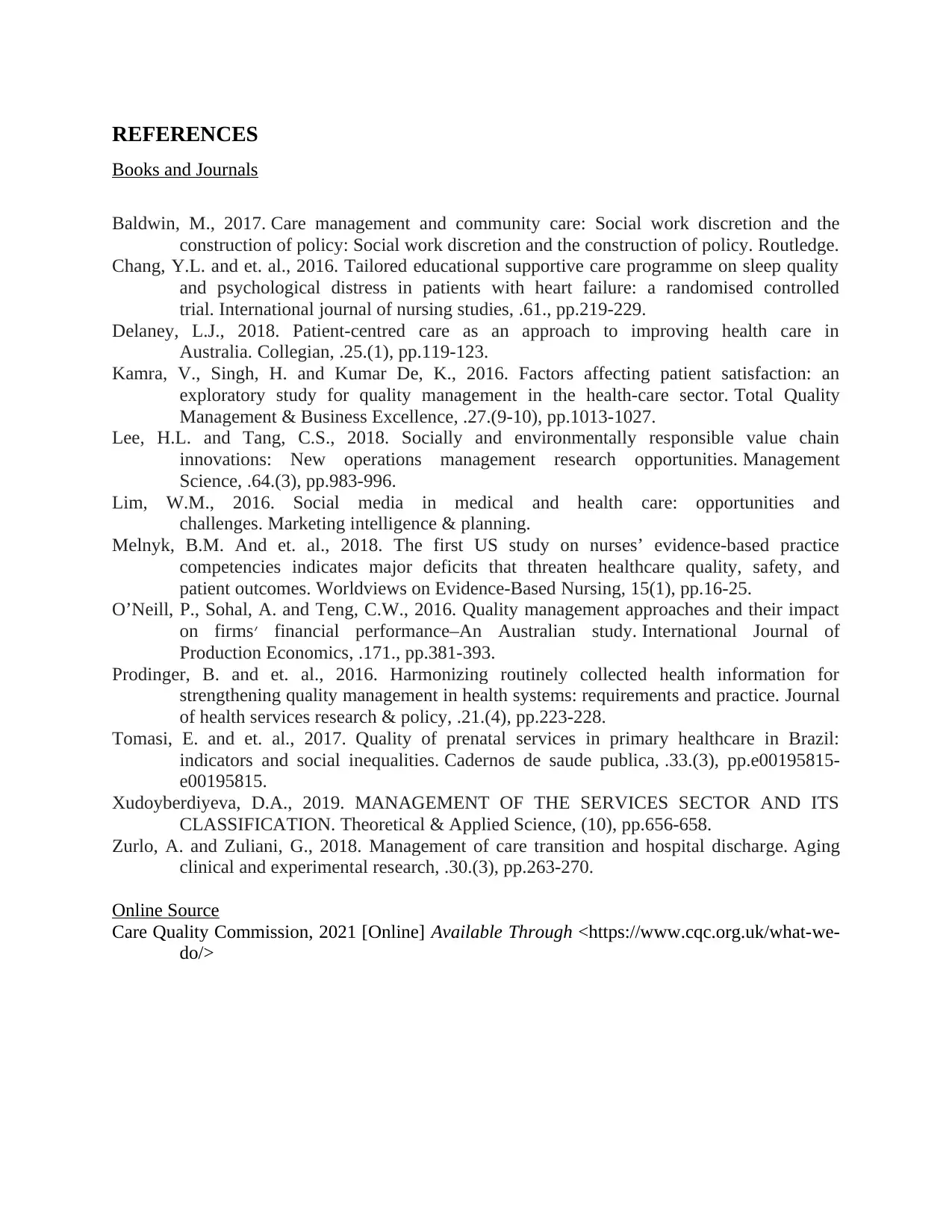
REFERENCES
Books and Journals
Baldwin, M., 2017. Care management and community care: Social work discretion and the
construction of policy: Social work discretion and the construction of policy. Routledge.
Chang, Y.L. and et. al., 2016. Tailored educational supportive care programme on sleep quality
and psychological distress in patients with heart failure: a randomised controlled
trial. International journal of nursing studies, .61., pp.219-229.
Delaney, L.J., 2018. Patient-centred care as an approach to improving health care in
Australia. Collegian, .25.(1), pp.119-123.
Kamra, V., Singh, H. and Kumar De, K., 2016. Factors affecting patient satisfaction: an
exploratory study for quality management in the health-care sector. Total Quality
Management & Business Excellence, .27.(9-10), pp.1013-1027.
Lee, H.L. and Tang, C.S., 2018. Socially and environmentally responsible value chain
innovations: New operations management research opportunities. Management
Science, .64.(3), pp.983-996.
Lim, W.M., 2016. Social media in medical and health care: opportunities and
challenges. Marketing intelligence & planning.
Melnyk, B.M. And et. al., 2018. The first US study on nurses’ evidence‐based practice
competencies indicates major deficits that threaten healthcare quality, safety, and
patient outcomes. Worldviews on Evidence‐Based Nursing, 15(1), pp.16-25.
O’Neill, P., Sohal, A. and Teng, C.W., 2016. Quality management approaches and their impact
on firms׳ financial performance–An Australian study. International Journal of
Production Economics, .171., pp.381-393.
Prodinger, B. and et. al., 2016. Harmonizing routinely collected health information for
strengthening quality management in health systems: requirements and practice. Journal
of health services research & policy, .21.(4), pp.223-228.
Tomasi, E. and et. al., 2017. Quality of prenatal services in primary healthcare in Brazil:
indicators and social inequalities. Cadernos de saude publica, .33.(3), pp.e00195815-
e00195815.
Xudoyberdiyeva, D.A., 2019. MANAGEMENT OF THE SERVICES SECTOR AND ITS
CLASSIFICATION. Theoretical & Applied Science, (10), pp.656-658.
Zurlo, A. and Zuliani, G., 2018. Management of care transition and hospital discharge. Aging
clinical and experimental research, .30.(3), pp.263-270.
Online Source
Care Quality Commission, 2021 [Online] Available Through <https://www.cqc.org.uk/what-we-
do/>
Books and Journals
Baldwin, M., 2017. Care management and community care: Social work discretion and the
construction of policy: Social work discretion and the construction of policy. Routledge.
Chang, Y.L. and et. al., 2016. Tailored educational supportive care programme on sleep quality
and psychological distress in patients with heart failure: a randomised controlled
trial. International journal of nursing studies, .61., pp.219-229.
Delaney, L.J., 2018. Patient-centred care as an approach to improving health care in
Australia. Collegian, .25.(1), pp.119-123.
Kamra, V., Singh, H. and Kumar De, K., 2016. Factors affecting patient satisfaction: an
exploratory study for quality management in the health-care sector. Total Quality
Management & Business Excellence, .27.(9-10), pp.1013-1027.
Lee, H.L. and Tang, C.S., 2018. Socially and environmentally responsible value chain
innovations: New operations management research opportunities. Management
Science, .64.(3), pp.983-996.
Lim, W.M., 2016. Social media in medical and health care: opportunities and
challenges. Marketing intelligence & planning.
Melnyk, B.M. And et. al., 2018. The first US study on nurses’ evidence‐based practice
competencies indicates major deficits that threaten healthcare quality, safety, and
patient outcomes. Worldviews on Evidence‐Based Nursing, 15(1), pp.16-25.
O’Neill, P., Sohal, A. and Teng, C.W., 2016. Quality management approaches and their impact
on firms׳ financial performance–An Australian study. International Journal of
Production Economics, .171., pp.381-393.
Prodinger, B. and et. al., 2016. Harmonizing routinely collected health information for
strengthening quality management in health systems: requirements and practice. Journal
of health services research & policy, .21.(4), pp.223-228.
Tomasi, E. and et. al., 2017. Quality of prenatal services in primary healthcare in Brazil:
indicators and social inequalities. Cadernos de saude publica, .33.(3), pp.e00195815-
e00195815.
Xudoyberdiyeva, D.A., 2019. MANAGEMENT OF THE SERVICES SECTOR AND ITS
CLASSIFICATION. Theoretical & Applied Science, (10), pp.656-658.
Zurlo, A. and Zuliani, G., 2018. Management of care transition and hospital discharge. Aging
clinical and experimental research, .30.(3), pp.263-270.
Online Source
Care Quality Commission, 2021 [Online] Available Through <https://www.cqc.org.uk/what-we-
do/>

⊘ This is a preview!⊘
Do you want full access?
Subscribe today to unlock all pages.

Trusted by 1+ million students worldwide
1 out of 12
Related Documents
Your All-in-One AI-Powered Toolkit for Academic Success.
+13062052269
info@desklib.com
Available 24*7 on WhatsApp / Email
![[object Object]](/_next/static/media/star-bottom.7253800d.svg)
Unlock your academic potential
Copyright © 2020–2025 A2Z Services. All Rights Reserved. Developed and managed by ZUCOL.




